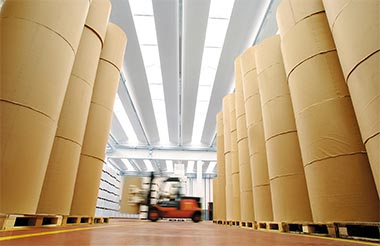Weyerhaeuser Company was a multi-billion dollar manufacturer of paper and forest products that recently sold their brown paper business to International Paper Company. Weyerhaeuser operated scores of corrugated box plants which were supplied with materials from their brown paper mills as well as multiple external suppliers.
The Problem
Weyerhaeuser management faced a complex decision environment in the sourcing of materials for manufacturing. Their box plants demanded substantially more paper than their manufacturing operations could supply and production planners were faced with the task of continuously balancing paper supply with box plant demand. Planners attempted to consider profit-sensitive questions related to manufacturing efficiencies and costs, outsourcing options, and transportation costs. Literally thousands of variables were in play within this business environment.
The Solution
Once the project was initiated, Optware Solutions was able to analyze the business and deliver a working system tailored to Weyerhaeuser’s needs within nine months. The System was designed to integrate with existing information systems for much of the required modeling data.
The scope of the Optware System on the supply side included paper manufacturing production rates and costs as well as machine “trim”. The term trim refers to machine width utilization. Paper is produced in a number of grades and roll widths. These widths must be combined in such as way as to fit a paper machine and maximize machine utilization. Trim must be considered in order to determine the best possible paper procurement strategy.
The scope of the System on the supply side also included paper purchase options and trades with other vendors. This type of arrangement is usually only applied to commodity markets.
The scope of the System on the demand side largely involved box plant paper demand by grade and size and, to a lesser extent, potential open-market opportunities. The box plants forecast their demand by reviewing the needs of the end-customer for boxes and backing into paper demand based on components from the bill-of-materials (BOM).
The solution was designed to maximize financial return subject to the business constraints, process flows, revenues and costs. The central technology that drives the system is a powerful linear-programming-based optimizer.
Prior to installation of the Optware System it was very difficult to manage the “fine points” of sourcing and scheduling strategies. Fortunately linear-programming thrives on complexity. A fractional percentage improvement in machine efficiency or transportation cost can easily translate into hundreds of thousands of dollars in cost savings.
Keys to success in the modeling effort:
- Aggressive, committed sponsorship by all levels of management
- Thorough review of the business to include all relevant variables
- Willingness to invest in data systems
- Qualified liaison to mediate concerns of manufacturing and sales people
- User-friendly software that is carefully tested before implementation
- Consistent review process to track implementation progress
- Tracking system to track value delivered on an ongoing basis
The Results
Profit Optimization technology allowed Weyerhaeuser Company to treat dispersed operations as a single entity and to capture synergies across the business unit. The result was an improved planning process and over $10MM per year to the bottom-line.

Contact Optware today to schedule a consultation
503-645-2390 | info@optware.com



